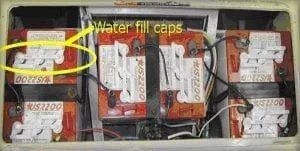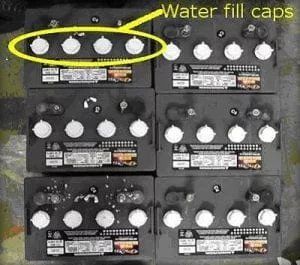,
This is a placeholder for the Yext Knolwedge Tags. This message will not appear on the live site, but only within the editor. The Yext Knowledge Tags are successfully installed and will be added to the website.
Arcadia, FL
Helpful Tips
Tips About Golf Cart Batteries and Voltage
- Free Consultation- Large Selection of New & Used Carts- Warranties Available on New Products
Visit Us
Understand Golf Cart Battery Care and Voltage Better
Problems can arise with the performance of your golf cart's battery at any time. These can be prevented by following the right procedures when it comes to battery care. At Cart City, we'll provide you with some helpful tips regarding battery operation, battery care, and determining voltage. Contact
us for more information.
Check Out Some Methods of Battery Care
Charging:
- Correct charging methods extend battery life and range between charges
- Charge new batteries completely before they are used the first time
- Charging time will probably be at least 12 hours
- New batteries need up to four hours more charging time than mature batteries
- Schedule enough charging time, if possible, so the charger shuts off automatically
- Age of battery, condition of the battery, state-of-discharge, the temperature of the electrolyte, AC line voltage level, and other variables affect charging time
- Limit the use of new batteries between charging for the first 5-20 cycles (new batteries have less capacity than batteries which have been broken in)
- New golf car batteries should be limited to 18 holes between charges
- Industrial vehicle batteries should not be discharged more than 20-30% before recharging
- Whenever possible, for the longest battery life, recharge batteries as soon as they become 20% discharged (1.233 SG / 37.38 volts)
- Never allow batteries to fall below 80% discharged (1.148 SG / 35.94 volts)
- Deep discharging significantly reduces battery life
- Batteries in storage self-discharge and should be recharged whenever the specific gravity falls below 1.240
- The rate of self-discharge varies directly with temperature
- Battery state-of-charge can be determined by using a hydrometer, or by connecting the charger and observing the charging rate
- If the ammeter needle jumps smartly to 20-25 amps and then tapers below 14 amps within 15 minutes, the battery is fully charged.
Watering:
- Correct watering techniques extend battery life
- Check the electrolyte level on new batteries before putting them into service, and at least monthly for batteries in service
- Water use increases as batteries age
- Never allow the electrolyte level to fall below the top of the plates
- If the plates are exposed, add only enough water to cover the plates before charging
- Do not overfill batteries
- Electrolyte expands and can overflow during charging
- Water added to replace the spillage dilutes the electrolyte and reduces its specific gravity
- Cells with lower specific gravity have lower charging capacity
- Make sure the electrolyte covers the plates before charging and fill cells to the markers only after batteries are charged
- Use only distilled water
- Electric vehicle batteries may use up to 16 quarts of water during their useful lives, and non-distilled water may contain harmful minerals which will have a cumulative adverse effect on battery performance
Cleaning:
- Acid-soaked dirt on the battery tops causes current leakage and reduced battery efficiency
- Hose wash battery tops periodically with clean low-pressure water to keep them free of acid spillage, dirt, grass cuttings, and other debris
- Make sure vent caps are secure before washing
- Do not hose wash electronic controllers, switches, solenoid, and other electrical control devices. Cover them if necessary
- Wash the tops with a baking soda mixture (1/2 cup per quart of water) and a stiff bristle brush if a low-pressure hose doesn’t remove the dirt
- Rinse with clean water
- Make sure the battery tops are clean and dry before putting them into storage
Determining how many volts your golf cart uses is as easy as counting the water fill caps on the batteries. Lifting your golf cart’s seat reveals the battery compartment. The water fill caps are located on each battery.
Each battery cell covered by a cap is 2-volts. Simply count all of the battery fill caps on your batteries, multiply this total by two, and you will have determined your golf cart’s voltage. Gas golf carts utilize one 12-volt battery.
Learn More About Golf Cart Battery Care
Free consultations are available.
Get Directions
CHURCH ST LOCATION
,
This is a placeholder for the Yext Knolwedge Tags. This message will not appear on the live site, but only within the editor. The Yext Knowledge Tags are successfully installed and will be added to the website.
This is a placeholder for the Yext Knolwedge Tags. This message will not appear on the live site, but only within the editor. The Yext Knowledge Tags are successfully installed and will be added to the website.
This is a placeholder for the Yext Knolwedge Tags. This message will not appear on the live site, but only within the editor. The Yext Knowledge Tags are successfully installed and will be added to the website.
HARPER AVE LOCATION
Cart City Inc.
23165 Harper Ave
Port Charlotte, FL 33980
This is a placeholder for the Yext Knolwedge Tags. This message will not appear on the live site, but only within the editor. The Yext Knowledge Tags are successfully installed and will be added to the website.
This is a placeholder for the Yext Knolwedge Tags. This message will not appear on the live site, but only within the editor. The Yext Knowledge Tags are successfully installed and will be added to the website.
FREEDOM AVE LOCATION
Cart City Inc.
23196 Freedom Ave.
Port Charlotte, FL 33980
This is a placeholder for the Yext Knolwedge Tags. This message will not appear on the live site, but only within the editor. The Yext Knowledge Tags are successfully installed and will be added to the website.
This is a placeholder for the Yext Knolwedge Tags. This message will not appear on the live site, but only within the editor. The Yext Knowledge Tags are successfully installed and will be added to the website.
CARLSTROM FIELD LOCATION
Cart City Inc.
1985 SE Carlstrom Field RD
Arcadia, FL 34266
Main: (863) 336-5544
HOURS
This is a placeholder for the Yext Knolwedge Tags. This message will not appear on the live site, but only within the editor. The Yext Knowledge Tags are successfully installed and will be added to the website.
HOURS
This is a placeholder for the Yext Knolwedge Tags. This message will not appear on the live site, but only within the editor. The Yext Knowledge Tags are successfully installed and will be added to the website.
This is a placeholder for the Yext Knolwedge Tags. This message will not appear on the live site, but only within the editor. The Yext Knowledge Tags are successfully installed and will be added to the website.
Hi. Do you need any help?
Privacy Policy
| Do Not Share My Information
| Conditions of Use
| Notice and Take Down Policy
| Website Accessibility Policy
© 2024
The content on this website is owned by us and our licensors. Do not copy any content (including images) without our consent.






Share On: